A Comprehensive Piece on the Three Act Structure
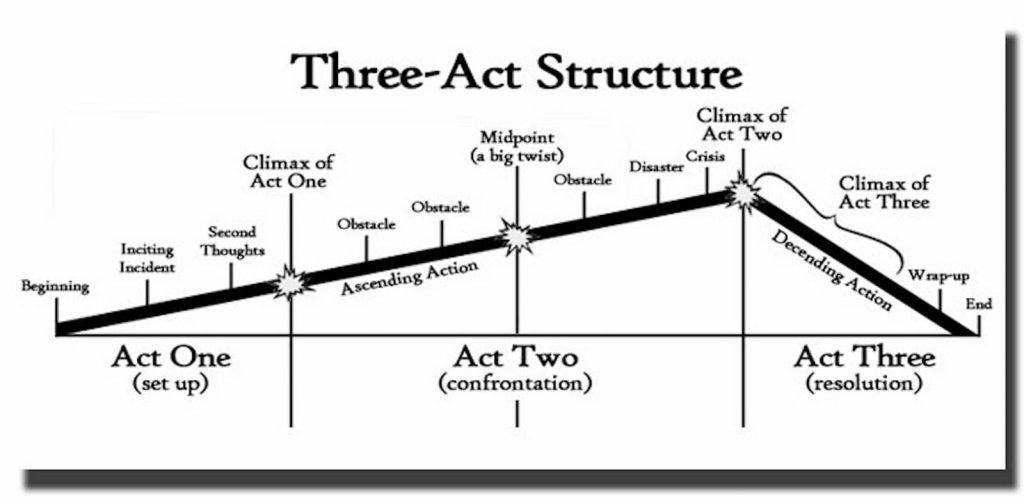
Any aspiring author and even screenwriter should learn about the Three Act Structure, a basic storytelling model that defines important plot points and how they should be placed in a novel or screenplay. Most stories and movies conform to a variation of the three-act structure, and its simplicity makes it a great tool to use for beginner writers.
The main idea of the Three Act Structure is that a story will always have a beginning, a middle, and an end. The Three Act Structure also focuses on the concept of causality; that all events are caused and will result in another event.
It should be noted that many variations of the Three Act Structure exist, such as the 27 Chapter Method, which further break down each act into blocks/chapters, which you might want to check out if the Three Act Structure might be too general for you.
The Three Acts in the Structure
The three acts represent the beginning, middle, and end of a story. The first Act is called the Setup, the second being the Confrontation, and the last being the Resolution. The most basic of the three act plot only indicates what each Act should contain, which can be too vague for many people.
A popular variation of the Three Act Structure divides each act into three parts, listed below.
- Setup
- Exposition
- Incitement
- Plot Point 1
- Confrontation
- Rising Action
- Midpoint
- Plot Point 2
- Resolution
- Pre-Climax
- Climax
- Denouement
It should be noted that despite being called the Three Act Structure, a novel is not equally divided into three parts. Each Act has a unique expected length, which mostly serves as a guideline to help newer writers usher specific plot points in a cadenced manner.
The Setup
The first Act, the Setup, only usually takes up the first 25% of a novel. It starts with the Exposition, where the character and the normal world are introduced. The point of the Exposition is to set up the contrast of a character’s typical life and how it will be changed by the major conflict in the story. This part also introduces important characters and events that will be referenced later on in the story.
The most important part of the Setup is the Incitement, or the call to action/adventure. After introducing the daily life of the character, you must then create an incident which will threaten this daily life. The Incitement is important because this will drive your plot forward: this is the motivation that will start your story.
The Incitement often breaks your character outside of their comfort zone, and this must be compelling enough to force your character to engage and face the threat, which would be Plot Point 1. The close-knit relationship of the Incitement and Plot Point 1 often makes it that these two events happen in quick succession.
Plot Point 1 serves as the transition from Act 1 to Act 2, the Confrontation.
The Confrontation
The second Act, Confrontation, often takes up the bulk of your story, around 50% or even more, depending on how you write it. The first part, the Rising Action, usually entails a series of unforgiving trials that the character goes through. It is rightfully called the rising action since you try to raise the stakes or the action against your character. Often, your character will come out of these trials victorious, but will end up losing something or winning only by the nick of time.
When you’re nearing the middle part of your novel, you should now introduce the Midpoint, when your character’s goal is now being actively blocked. This is usually introduced in one or at the end of the mundane trials from the Rising Action. The Midpoint should emphasize how high the stakes are right now.
The Midpoint is important because this is when your character starts to truly get involved with the conflict. Your character starts to take matters into their own hands, moving the plot actively because the threat to their goal is now apparent, and that without their action, they will never achieve success.
The Midpoint then ushers in Plot Point 2, which covers the parts where the character falls into despair. After getting involved with the conflict, they encounter their greatest defeat yet, plunging them into their lowest point. This should be the worst crisis your character will have suffered so far, from which they will bounce back in Act 3.
The Resolution
The third Act, Resolution, can easily take the least content of your novel, around 25% or less, yet this is where all the buildup from the previous two acts culminate. This is where your story reaches its highest physical, mental, and emotional intensity.
Of course, before that specific scene or sequence of events start, you should start with the Pre-Climax. The Pre-Climax can often get mixed up with Plot Point 2 from the Confrontation, as these parts often show the darkest moments of the character in the story. This specific drop into despair is also known as the “dark night of the soul,” and it can occur either at the end of Plot Point 2 or the start of Pre-Climax.
However, the important role of the Pre-Climax is to prepare the character for the Climax, the most intense scenes in your novel. In the Climax, your character is now facing the conflict and the antagonist head-on, with no choice left but to fight for their life. This is where your story peaks; everything that you have written so far rides upon the success (or failure) of the character in this battle.
After an intense face-off, the story reaches the Denouement, or the finale. Here, your character achieves (or cannot any more achieve) their goal, allowing them to be able to go back to their normal life. However, the tribulations that your character faced in the story will make them a truly changed person.
The Denouement is where you get to clean up plot holes and re-emphasize the theme of your novel. This is also where you release all the tension built up from the Climax, coming back to the peace of Act 1.
The Three Acts in Practice
Now that you know what each Act does, let’s take a real example, The Hunger Games by Suzanne Collins, who personally uses the Three Act Structure in the novel.
The Setup
- Act 1 starts with the Exposition of Katniss as a responsible teenager living in the poorest district who hunts illegally to feed her family.
- The Inciting Incident is when Katniss’ beloved younger sister, Prim, is randomly chosen to participate in the Hunger Games.
- This directly drives into Plot Point 1, where Katniss takes her sister’s place as a volunteer Tribute.
The Confrontation
- Act 2 starts with the Rising Action, where Katniss trains to survive the Games. Once the Game starts, she faces many trials, such as gathering supplies and getting hunted by her fellow Tributes.
- In the Midpoint, Katniss finally takes action to escape their clutches. This is the event that convinces her to stop running and start fighting to win the Games.
- Katniss later tracks down Peeta, fights another Tribute for medicine that will heal his injured leg, and makes sacrifices to keep them both alive, befitting for Plot Point 2 that prepares Katniss for Act 3.
The Resolution
- Act 3 starts with Katniss’ plunge into despair, as the mutated hounds chasing her bear striking resemblances to deceased Tributes, including those she killed. This Pre-Climax triggers Katniss’ traumas back to life.
- After killing Cato as an act of mercy, Katniss and Peeta, as the remaining Tributes, defy the Capitol’s demands of killing each other by attempting to commit a double suicide through poisonous berries, in a truly Climactic fashion.
- The Denouement ends with Katniss and Peeta being declared the duo winners of the Hunger Games, after having the Games cut short for their attempted suicide. They are safe, with a foreboding sense of danger for the days to come.
How to Use the Three Act Structure in LivingWriter
Now that you understand the Three Act Structure, you might be excited to get to work with your first bestseller. Hold your horses, however, as now we’ll tell you how to get a headstart with this framework in LivingWriter.
1. Open LivingWriter. In the Templates section, choose the Three Act Structure. This will show you a dialog where you will put your novel’s title and some optional details.
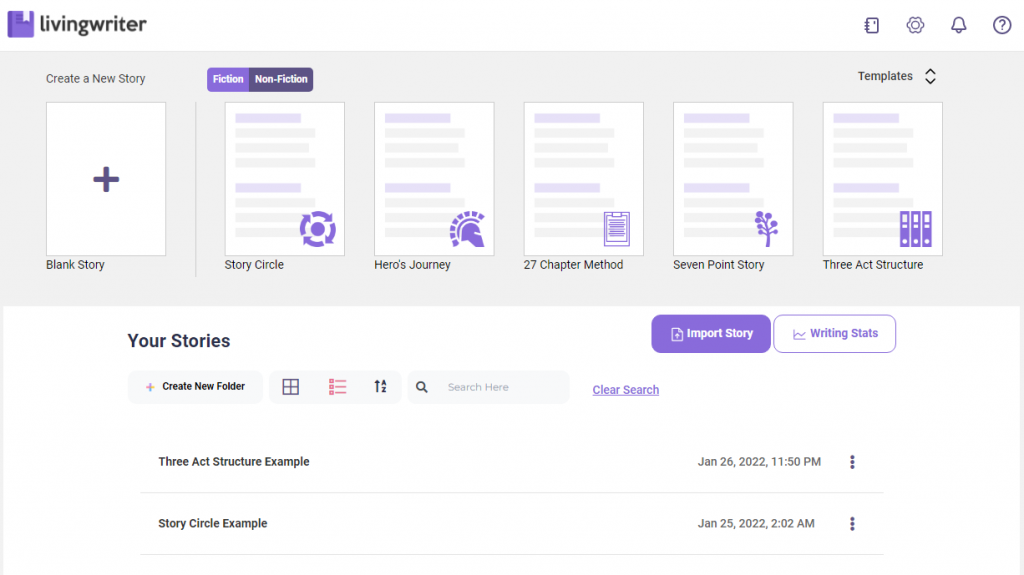
2. After filling up the dialog box, you will then be ushered into LivingWriter’s main page. The left sidebar contains all the plot points from the Three Act Structure we discussed above, while the right sidebar contains pre-filled information about each plot point to help guide you as you write. The middle part is for editing your manuscript.
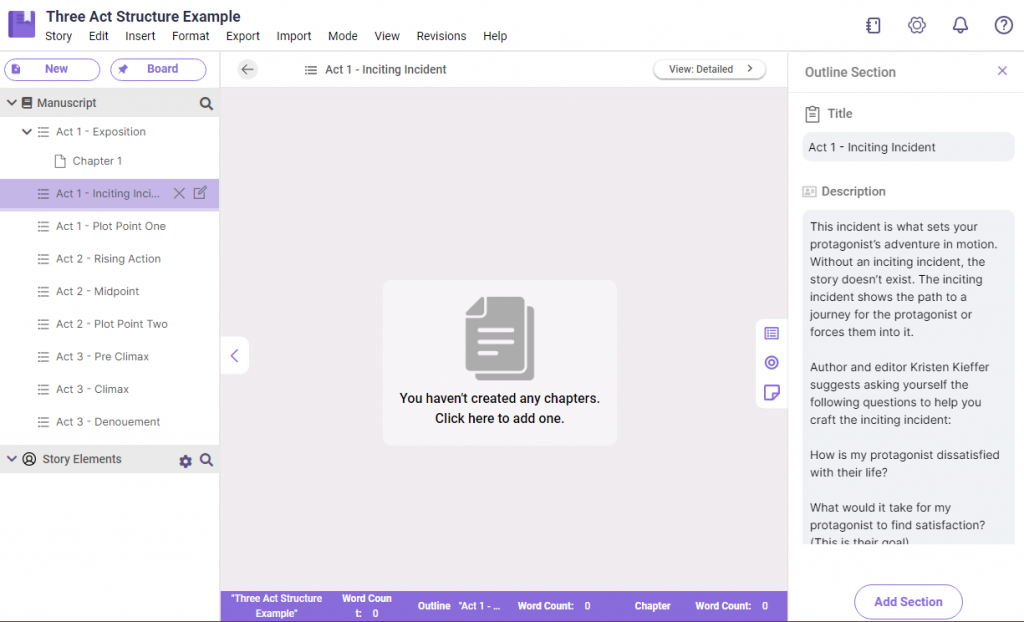
3. To have a better look at the outline of your story, click on the Board button in the left sidebar, then click Outlines and Chapters. This will change the middle section into a space with boxes representing each plot point. This view is better for editing your outline, being able to see all points easily.
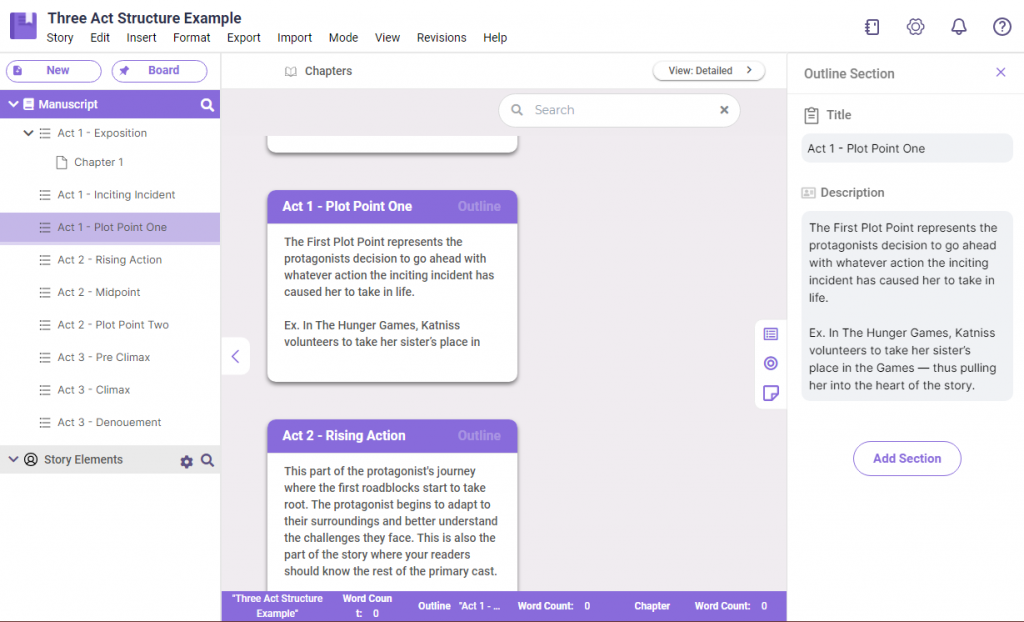
If you want to see a better, linear view of your plot points, you can use the Plot Board instead.
To access the Plot Board, click on the Board button in the left sidebar then go to Plot Board. This will change the middle section into the Plot Board.
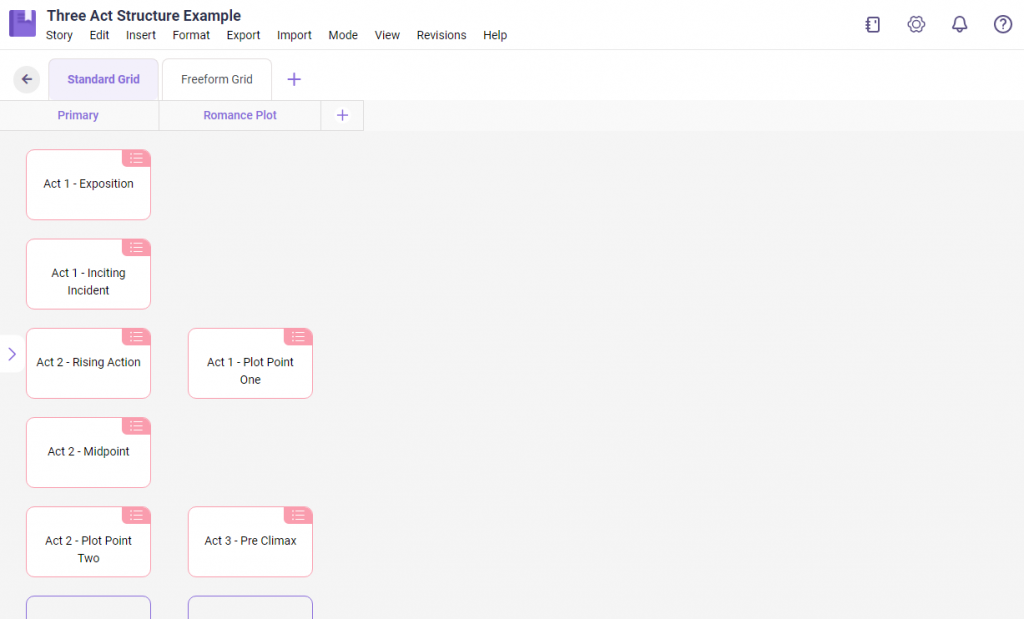
The Plot Board is a great way to visually see your plot points in a linear manner, rather than the card view in the Outlines and Chapters. However, the best use case for the Plot Board is to manage all subplots in your story. Adding a subplot is as easy as adding a new plot line and then adding a plot point in the same line where it’s supposed to develop, in terms of the main plot.
If you want a more involved Board, you can opt for the Freeform Grid instead, where you can create a sort of a plot point map and connect them to each other in a visual way.
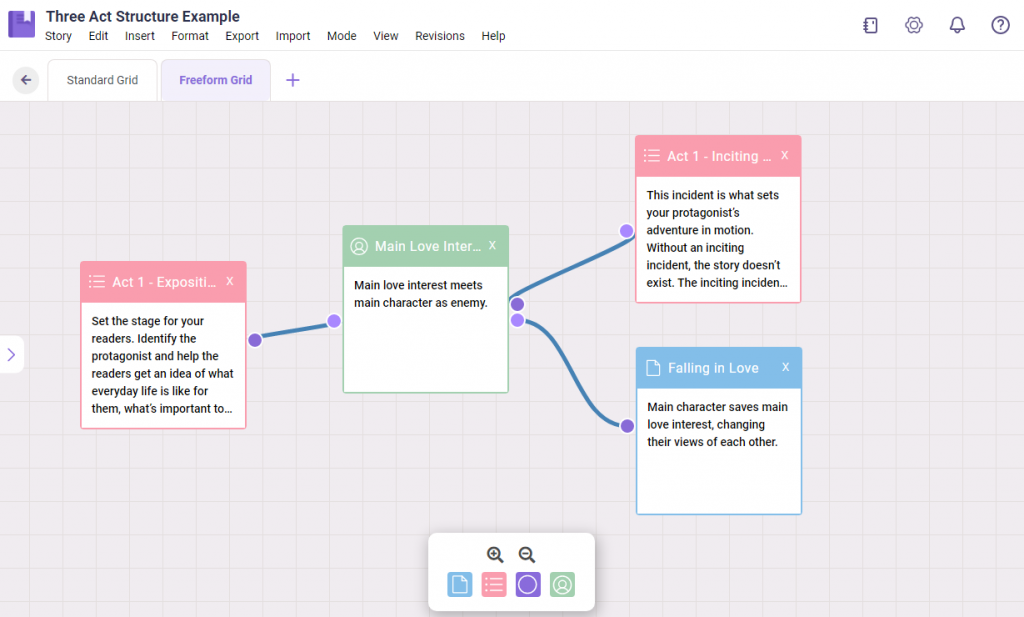
Now that you know how to use both LivingWriter and the Three Act Structure, you can now be confident that your first novel will be a great hit!